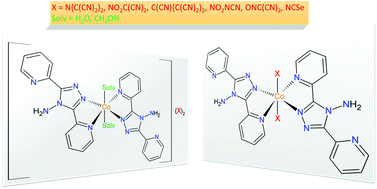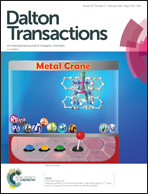Effect of linear and non-linear pseudohalides on the structural and magnetic properties of Co(ii) hexacoordinate single-molecule magnets†
Abstract
A series of mononuclear hexacoordinate Co(II) complexes with the 4-amino-3,5-bis(2-pyridyl)-1,2,4-triazole (abpt) ligand and various linear and non-linear pseudohalides, such as NCSe (selenocyanate), N{C(CN)2}2 (1,1,3,3-tetracyano-2-azapropenide, tcap), NO2C(CN)2 (nitrodicyanomethanide, nodcm), C(CN){C(CN)2}2 (1,1,2,3,3-pentacyanopropenide, pcp), NO2NCN (nitrocyanamide, nca), and ONC(CN)2 (nitrosodicyanomethanide, ndcm), was prepared. X-ray analyses revealed the formation of the complexes with the general compositions [Co(abpt)2(solv)2]X2 (solv = H2O and X = tcap (1), solv = H2O and X = nodcm (2), solv = CH3OH and X = pcp (3)) or [Co(abpt)2(X)2] (X = nca (4), X = NCSe (5), X = ndcm (6)). The impact of axial co-ligands (solv or X) on the magnetic properties was investigated experimentally by measuring temperature- and field-dependent static (DC) and dynamic magnetic (AC) data as well as theoretically using the CASSCF/NEVPT2, AILFT, and AOM methods. Large magnetic anisotropy was found for all complexes 1–6 and was treated either by the spin Hamiltonian or with the Hamiltonian including the orbital angular momentum. Furthermore, the AC susceptibility measurements confirmed the slow relaxation of the magnetization in a non-zero static magnetic field, thus these complexes can be classified as field-induced single-molecule magnets with an estimated energy barrier Ueff up to 100 K.



 Please wait while we load your content...
Please wait while we load your content...